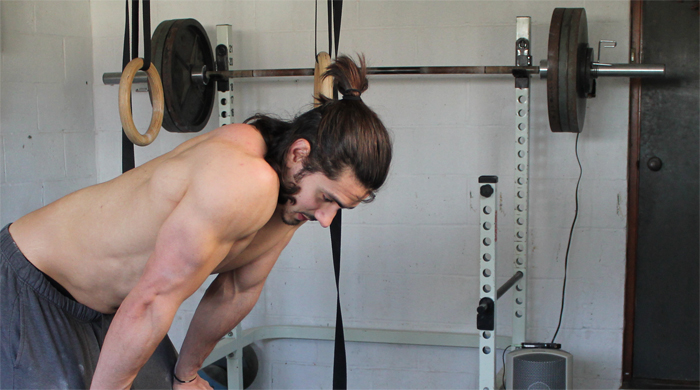1. This is me spouting some of my experiences and my philosophy on the relationship between barbell and bodyweight training (primarily how to combine both). It’s certainly not the only thing in the world that works—I don’t know if there’s magic here—but I know that it has worked for me. 2. I wrote two articles [...]

1. This is me spouting some of my experiences and my philosophy on the relationship between barbell and bodyweight training (primarily how to combine both). It’s certainly not the only thing in the world that works—I don’t know if there’s magic here—but I know that it has worked for me.
2. I wrote two articles before this, so that this didn’t end up 10x longer than it already is.
2a. This first article was about context.
2b. This second article was about the differences between barbell and bodyweight training.
3. It starts with context, which shouldn’t be surprising. What you want determines what you should do. It sounds so stupid that I don’t want to have to point it out, but it is a common handcuff. Want to become a bodyweight beast with no regard for muscle mass? Then you’re going to be doing something different than someone that wants to be decent in bodyweight skills, but would rather be jacked.
4. This is a point struggle for myself, even to this day. Because I want it all. I want to be able to do high level gymnastics skills, lift heavy barbells, jump to the moon, fiddle with acrobatic fast-twitch mischief, and not give a lick about recovery. Oh yeah, don’t forget that whole x physique thing. Perhaps better stated: I want to look well built and do cool shit.
5. Because, Goku.
6. If someone came to me with the same goals, I’d probably want to punch him in the face. And then I’d tell him he’d probably need to specialize in just one of those areas. And I’d say this because the more ends you chase, the slower your results will be.
6a. But this might be one of those instances where you’re better off listening to what I do, not what I say. (Actually, you’re always better off doing this.) Fortunately for me, I can mentally cope with banging my head against a wall, trying to do all of these things at once, only to see no results. I can also cope with slower progress because my brain isn’t infected with the idea that changing your body is an easy or fast process. Not saying that failure is the rule, but as some point you have to admit: it’s dangerous trying to juggle five knives when you can’t even throw one up and catch it safely.
7. Given #4, I think using Olympic weightlifters and gymnasts as archetypes of sorts is a good idea. High level Olympic weightlifters that keep their body fat down tend to develop a certain kind of physique, as do gymnasts. They also both train with a higher frequency, so we’re looking at juggling similar knives. Logic isn’t quite 100% sound here, but it works for now.
8. Beyond #3 context, there’s a second big contextual piece: where you are now. It’s going to be easier to delegate training if you’re already capable of some strength lifts or bodyweight skills (if you can already juggle some knives).
9. Given #3 and #8, another piece of context is how often you can train. In the end, most of the things we’re working towards are skills, and skills need their share of practice.
10. With the goals on the table, I want to punch myself in the face. The more goals you have, the less progress you should expect in any one area. But acknowledging these goals is important because what you do should always prepare you for what’s to come. So thinking of the future, a centralized program that prepares you for different concentrations down the line is a good idea. Think river and tributaries. You can have the tributaries unless you have the main river.
11. Given the goals, it starts with the barbell. I’m sure there are people on the other side of the fence, but this is the side of the fence I ended up on. I think a barbell training delivers faster results because…
- There’s a smaller learning curve. You learn the movement and then the only remaining variable is adding weight or reps or whatever over time.
- There aren’t as many limiting factors. Usually barbell exercises stress the muscles and tissues that are targeted and aren’t held back by secondary links in the chain.
- There is a greater organism effect.
- They’re easier mentally. I personally wasn’t ready for the strain of gymnastics exercises. The barbell forces strain by crashing down upon your skeleton. But with bodyweight skills, it’s on you and your own brain to give it your all. I don’t know how else to describe this, but I’ll admit that took me a while to be mentally prepared for gymnastics exercises.
- The first two articles help understand the above points, so go read those. Context is here. Differences are here.`
12. Let’s qualify “barbell” real quick. I personally see weighted dips and weighted chin-ups as more barbell than bodyweight because they share the same characteristics as barbell exercises: heavy bone loading, not being held back by skill, overload being a tao of slapping more weight onto yourself, etc.
12a. Here’s another way I like to think about this:
- Beginner bodyweight: push-ups, pull-ups, chin-ups, unweighted dips, etc.
- Barbell bodyweight: weighted chin-ups and pull-ups and dips
- Party tricks: one arm chin-ups, one arm push-ups, one legged squats (pistols, king deadlifts, etc.)
- Gymnastics floor bodyweight: handstands, planches, levers, v- and l-sits, etc.
- Gymnastics ring bodyweight: the above on rings
12b. Surprise, surprise. The above looks like the bodyweight levels I talked about in previous articles.
13. Starting with a barbell doesn’t mean neglecting bodyweight training. But given barbell exercises are easier to dive into, and that you can make progress faster with them, that’s where I put the first flag. You can give your body a decent training stimulus while you level up your bodyweight ability — until you hit the cusp of “barbell bodyweight” and beyond.
14. For those that have mucked with high level bodyweight skills, you probably know barbell strength doesn’t correlate that well to bodyweight skill ability, so what gives? Keep our context and goals in mind. If you solely wanted to be a bodyweight master, things would change. For me, aesthetics was a big bottleneck. If you’re wrapped up in aesthetics, you’re probably going to feel uneasy unless you know you’re working on the problem.
14a. Don’t think of this as “the best uber-ultra way to tackle barbell training” or “the best uber-ultra way to tackle bodyweight training.” Think of it as the way I go about fusing them both together given the absurd goals that I initially put on the table. In other words: appreciate context.
15. Don’t tangle your Schwartz. Barbell training is good for barbell training. Bodyweight training is good for bodyweight training. (And even then, there are categories that pop-up within each category. For bodyweight skills, down the line, you have straight arm strength and bent arm strength. Totally different.) Field work (jumping, hoping, etc.) is field work. Your mind is in a much better place if you see everything you do as a vehicle for just that: what’s being done.
15a. Sure, being able to squat a bit more weight might do you some good in the vertical jump department if you couldn’t squat much to begin with. Sure, being able to do some chin-ups might do you some good in the front lever department if you couldn’t do any chin-ups to begin with. There are many “Sure,” cases, but after an initial pseudo-beginner relationship, they all lose their zest.

16. Although they’re best seen as their own unique entities, there’s a sort of emergence that comes from combining barbell and bodyweight training — the whole becomes greater than the sum of its parts, as is the case in any good fusion. Gotenks is stronger than Goten and Trunks.
- Barbell training is usually more organism taxing. There’s more grip work, spine loading, and it just seems to hit the entire system harder. Bodyweight training is less taxing, which means it’s easier for high frequency fiddling.
- Barbell training forces you into a fixed vertically loaded movement plane most of the time. Bodyweight training allows for more movement freedom.
- Because of the load, barbell training makes for a more bone bearing sort of tension and load. Bodyweight training, because of the freedom, allows you to adjust position and produce more tension through torque.
- You can get better at barbell exercises while simultaneously turning into a fat slob. You can’t get better at bodyweight exercises and turn into a fat slob because you’re proficiency hinges on relative strength. Getting better at both makes for good things.
17. Perhaps the most interesting relationship of all comes from something Christopher Sommer said: gymnasts are “masters” of the shoulder joint, Olympic weightlifters are “masters” of the hip joint.
18. This makes it seem like the best idea is to simply jam them together, but that’s harder done than said. They are “masters” because they devote 100% of themselves to be said masters. Taking both and sandwiching them together is like smashing two religions together. Combine that with the fact that we have more goals on the table, and it’s getting sticky.
19. This is where a little context pops back up because unless you’re 100% involved in a sport, you have freedom of choice. Sometimes it’s best not to try to play by rules you don’t have to play by, but instead to take what’s most applicable.
Jeet Kune Do favors formlessness so that it can assume all forms and since Jeet Kune Do has no style, it can fit in with all styles. As a result, Jeet Kune Do utilizes all ways and is bound by none and, likewise, uses any techniques which serve its end.
In Jeet Kune Do, it’s not how much you have learned, but how much you have absorbed from what you have learned. It is not how much fixed knowledge you can accumulate, but what you can apply livingly that counts.
20. And so we get to an idea like this: If your goal is to do Judo, then go do Judo. If your goal is to do Taekwondo, then go do Taekwondo.
20a. But if your goal is to win a fight? Then maybe you should be formless.
21. The goal of being formless is taking the most applicable techniques from domains that exist and not being a slave to arbitrary rules. The problem with doing this: we’re terrible retrospective thinkers. It’s easy to fall trap to our own biases, so we need to take a macro look and extract only the big principles.
22. I’ll save that for next time.